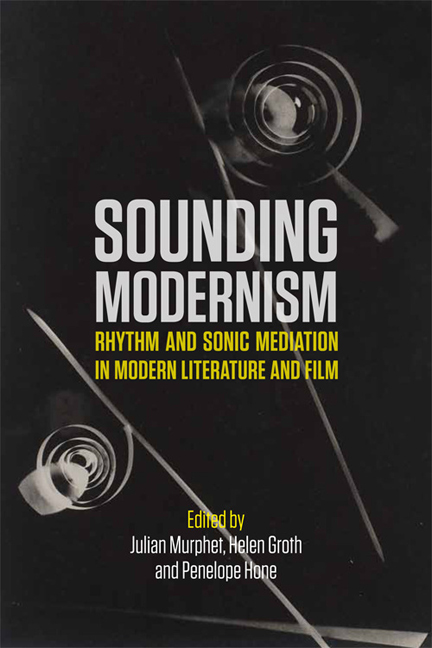Book contents
- Frontmatter
- Contents
- Acknowledgements
- 1 Introduction: Sounding Modernism 1890–1950
- Part One Writing Modern Sound
- Part Two Mediated Voices
- 4 Bottled Bands: Automatic Music and American Media Publics
- 5 How to Listen to Joyce: Gramophones, Voice and the Limits of Mediation
- 6 Sounding Region, Writing Accent: A. G. Street and the BBC
- 7 Partial to Opera: Sounding Willa Cather's Empty Rooms
- 8 Elliptical Sound: Audibility and the Space of Reading
- Part Three Difficult Voices
- Part Four Modern Rhythm: Writing, Sound, Cinema
- Notes on Contributors
- Bibliography
- Index
4 - Bottled Bands: Automatic Music and American Media Publics
from Part Two - Mediated Voices
Published online by Cambridge University Press: 22 December 2017
- Frontmatter
- Contents
- Acknowledgements
- 1 Introduction: Sounding Modernism 1890–1950
- Part One Writing Modern Sound
- Part Two Mediated Voices
- 4 Bottled Bands: Automatic Music and American Media Publics
- 5 How to Listen to Joyce: Gramophones, Voice and the Limits of Mediation
- 6 Sounding Region, Writing Accent: A. G. Street and the BBC
- 7 Partial to Opera: Sounding Willa Cather's Empty Rooms
- 8 Elliptical Sound: Audibility and the Space of Reading
- Part Three Difficult Voices
- Part Four Modern Rhythm: Writing, Sound, Cinema
- Notes on Contributors
- Bibliography
- Index
Summary
Beginning around 1890 nickel-in-the-slot machines were used to vend a range of goods and services in metropolitan areas across the United States. It started with gum machines, apparently, and spread from there. Scientific American magazine called it a ‘craze’ and the Commissioner of Patents called it a ‘flood’. ‘It begins to look as if the drummer and the saleslady [will] be superseded by this speechless monster’, he offered, ‘and [soon] every mortal want [will] come to be supplied through the slot’ (223). As speechless monsters or so-called silent salesmen, vending machines were defined partly according to the sounds of exchange they replaced: the patter and pressure of sales talk, drumming, near relations of hawking, barking, street cries, and the palaver of auctioneers. Yet none of these machines, it must be admitted, was technically silent. Not only did the new vending machines come with a peculiar repertoire of mechanical noises – gears grinding, clicks and whirs – the most popular among them for a time were the automatic phonographs that played a minute or two of pre-recorded sound for every nickel.
The nickel-in-the-slot phonograph and its contemporary, the multiuser exhibition phonograph (for which nickels were collected by hand), both enjoyed relatively brief popularity before fading from view amid the popular success of home phonographs, gramophones and mass-produced musical records during the first decade of the twentieth century. Automatic phonographs are a footnote in the history of Las Vegas slot machines, then, a fossil amid the genealogy of the jukebox. But they are important to a history of aural cultures in the US on a number of counts. Most notably, as Jonathan Sterne has argued, the ‘audile technique’ of listening through hearing tubes helped to ‘construct an individuated, localized sound space’ for consumers, an acoustic space that was ‘modeled on the form of private property’. So at the same time that nickel-in-the-slot phonographs helped to suggest that musical playback (rather than office dictation, say) was what phonographs might be for in the next century, nickel-in-the-slot phonographs also helped newly to commodify sound and audible performance, modelling private property coincident with – that is, as – a specific audile interiority.
- Type
- Chapter
- Information
- Sounding ModernismRhythm and Sonic Mediation in Modern Literature and Film, pp. 55 - 62Publisher: Edinburgh University PressPrint publication year: 2017



